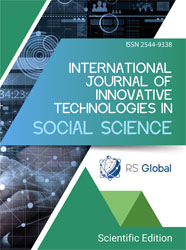DECODING THE IRREGULARITY IN THE CASBAH URBAN FABRIC
Abstract
This study aims at explaining how the urban fabric of the Casbah City (Algiers) emerged and the mechanisms that produced such an urban pattern. The research focuses on the study of the impact of some Islamic laws; preemption, inheritance, the right of precedence, and endowments (waqf) on the morphology of streets, plots and blocs that constitute the irregular urban fabric. The study relies on the old maps of the Casbah and its topography to illustrate such physical and spatial impact. It concludes that the urban fabric was the result of the symbiosis of natural factors, mainly the terrain, the orientation and the waterways, and the legal mechanisms that turned into social practices.
This paper can help students of architecture and urban planning understand how the urban fabric of Casbah was constructed.
References
Amoura, Rima, and Krimo Dahmani. 2022. “Visualization of the Spatial Extent of Flooding Expected in the Coastal Area of Algiers Due to Sea Level Rise. Horizon 2030/2100.” Ocean and Coastal Management 219(August 2021). doi: 10.1016/j.ocecoaman.2022.106041.
Bedredine belkadi-Mustapha Benhamouche - Albert Devoulx. 2003. El Djazaïr : Histoire d’une Cité d’Icosium à Alger. Enag Editi. Alger.
Ben-Hamouche, Mustapha. 2003. “DECISION-MAKING TRADITIONAL SYSTEM AND URBAN GEOMETRY IN MUSLIM CITIES: THE CASE OF ALGIERS 1516-1830.” Journal of Architectural and Planning Resear Vol. 20, N:307–22.
Ben-Hamouche, Mustapha. 2007. Masājid Madīnat Al-Jazāʼir Wa-Zawāyāhā Wa-Aḍriḥatuhā Fī Al-ʻahd Al-ʻUthmānī : Min Khilāl Makhṭūṭ Dīfūlkis Wa-Al-Wathāʼiq Al-ʻUthmānīyah. Dār al-Ummah.
Ben-Hamouche, Mustapha. 2009a. “Can Chaos Theory Explain Complexity in Urban Fabric? Applications in Traditional Muslim Settlements.” Nexus Network Journal 11(2):217–42. doi: 10.1007/s00004-008-0088-8.
Ben-Hamouche, Mustapha. 2009b. Dar Es-Sultân: L’algérois à l’époque Ottomane : Gestion Urbaine et Aménagement Du Territoire. edited by Dar El-Bassair. Alger.
Ben-Hamouche, Mustapha. 2011. “Fractal Geometry in Muslim Cities: How Succession Law Shaped Morphology.” Nexus Network Journal 13(1):235–51. doi: 10.1007/s00004-011-0062-8.
Ben-Hamouche, Mustapha. 2020. “Mapping Mosques of Old Algiers Before the French Colonial Demolitions: Through Albert Devoulx Manuscript (1870).” Journal of Urban History. doi: 10.1177/0096144220976123.
Chergui, Samia. 2011. Mosquées d’Alger - Construire, Gérer et Conserver (XVIe-XIXe Siècles). PU Paris-Sorbonne.
Chérif-Seffadj, Nabila. 2008. Les Bains d’Alger Durant La Période Ottomane (XVIe-XIXe Siècles). PU Paris-Sorbonne.
Devoulx, Albert. 1870. “LEDIFICE RELIGIEUX DE L’ANCIEN ALGER (EXTRAIT DE LA REVUE AFRICAINE).”
Djamil Abdelkader Akbar. 1988. Crisis in the Built Environment: The Case of the Muslim City. Singapore: Concept Media.
Grangaud, Isabelle. 2013. “La Hawma : Les Processus de Disqualification d’une Institution Ottomane (Alger 1830).” Insaniyat / إنسانيات (59):105–32. doi: 10.4000/INSANIYAT.13950.
Hadhloul, Saleh Ben Ali. 1996. The Arab-Muslim City:Tradition, Continuity and Change in the Physical Environment. Riyadh: Dar Al Sahan.
Hadjilah, Asma, and Nabila Chérif. 2020. “The Casbah of Algiers’s Transformation Between 1833 and 1859: Expropriation, Concession, and Plot Remodeling.” Journal of Urban History 46(4):889–907. doi: 10.1177/0096144219835158.
Haedo, Don Diiego. 1612. TOPOGRAPHIE ET HISTOIRE GÉNÉRALE D’ALGER. edited by : I. À. V. E. 1612 T. de l’espagnol par and M. le D. M. et A. B. E. 1870.
Hoexter, Miriam. 1998. Endowments, Rulers and Community: Waqf Al-Ḥaramayn in Ottoman Algiers. Leiden, Netherlands: Brill.
Missoum, Sakina. 2003. Alger à l’époque Ottomane La Médina et La Maison Traditionnelle. Edisud. Algérie.
Nadia Boudalia, Abdessamad Alilil Walid Hammai. 2018. “REQUALIFICATION OF THE URBAN VIDS OF THE LOW KASBAH OF ALGIERS.” 2(2):26–34.
Raymond, André. 1981. “Le Centre d’Alger En 1830.” Revue Des Mondes Musulmans et de La Méditerranée 31(1):73–84. doi: 10.3406/REMMM.1981.1905.
Raymond, André. 1998. La Ville Arabe, Alep, à l’époque Ottomane. edited by I. français d’études arabes de D. Presses de l’Ifpo. Damas.
Saidouni, Nscereddine. 2009. Le Waqf En Algérie à l’époque Ottomane: XIe-XIIIe Siècles de Hégire : XVIIe-XIXe Siècles : Recueil de Recherches Sur Le Waqf. 2éme. Koweit: Fondation publique des awqaf du Koweït.
Saliha DJEDDI, Baya BENNOUI. 2021. “CONTRIBUTION TO THE STUDY OF THE OLD ALGIERS’S WALL AND THE DEVELOPMENT OF ITS CONSTRUCTIVE SYSTEM.” RIMAK International Journal of Humanities and Social Sciences 3(7):80–88. doi: http://dx.doi.org/10.47832/2717-8293.7-3.8.
Shuval, Tal. 2002. La Ville d’Alger Vers La Fin Du XVIIIe Siècle : Population et Cadre Urbain. edited by CNRS Éditions. Paris.
Views:
555
Downloads:
406
Copyright (c) 2023 Mohammed Brahimi, Mustapha Benhamouche

This work is licensed under a Creative Commons Attribution 4.0 International License.
All articles are published in open-access and licensed under a Creative Commons Attribution 4.0 International License (CC BY 4.0). Hence, authors retain copyright to the content of the articles.
CC BY 4.0 License allows content to be copied, adapted, displayed, distributed, re-published or otherwise re-used for any purpose including for adaptation and commercial use provided the content is attributed.











